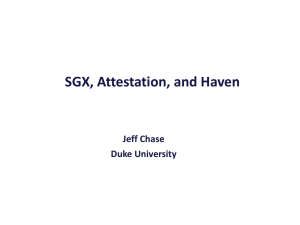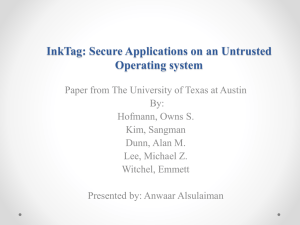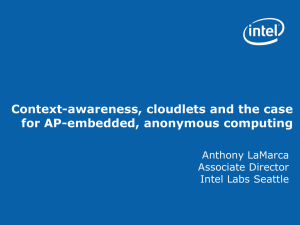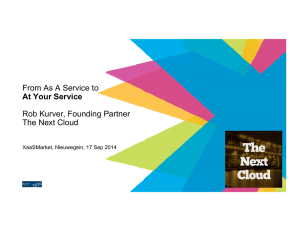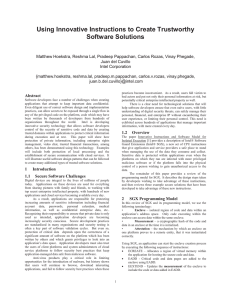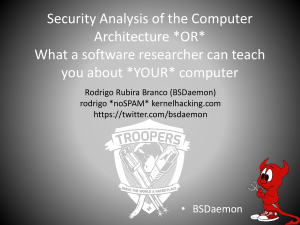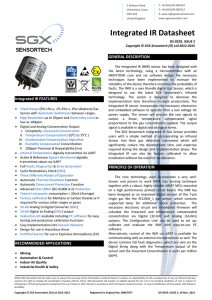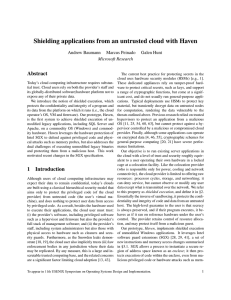slides2
advertisement
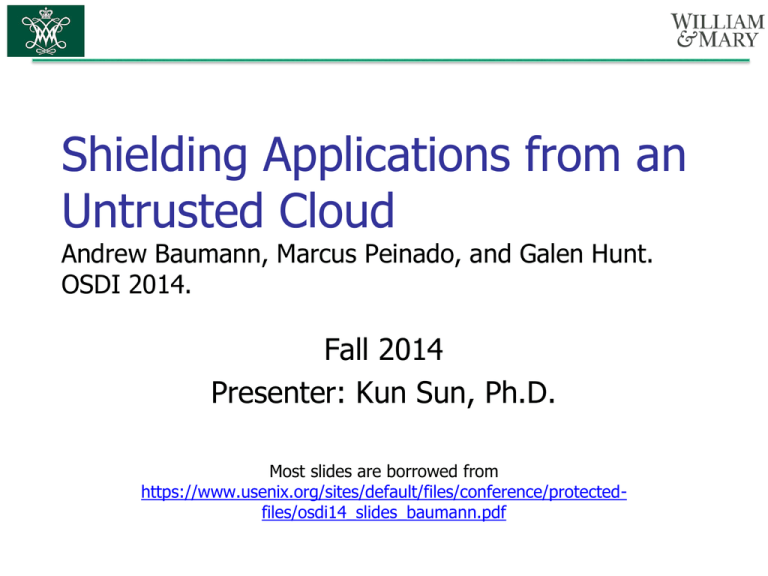
Shielding Applications from an Untrusted Cloud Andrew Baumann, Marcus Peinado, and Galen Hunt. OSDI 2014. Fall 2014 Presenter: Kun Sun, Ph.D. Most slides are borrowed from https://www.usenix.org/sites/default/files/conference/protectedfiles/osdi14_slides_baumann.pdf Outline Problem: can we trust the Cloud? Existing solutions New hardware solution Intel SGX Future work In the old days… The Goal of Haven Secure, private execution of unmodified applications (bugs and all) in an untrusted cloud on commodity hardware (Intel SGX) Can we trust the Cloud? Huge trusted computing base Privileged software Hypervisor, firmware, ... Management stack Staff (physical access) Sysadmins, cleaners, security Law enforcement (e.g., Snowdon) Security soncerns limits cloud adoption Hierarchical security model Observe or modify any data Even if encrypted on disk / net Current Approaches Hardware Security Modules Trusted Hypervisor Remote Attestation Hardware Security Modules Dedicated crypto hardware Limited set of APIs Tamper-proof Expensive Key storage Crypto operations Unprotected transient data Protects the “crown jewels”, not general-purpose Trusted Hypervisor Use a small, secure, hypervisor Ensures basic security, such as strong isolation Problem #1: system administrators Problem #2: physical attacks (e.g. memory snooping) Problem #3: tampering with hypervisor Remote Attestation Trusted hardware: TPM chip Specific software has been loaded Basic idea: Signed measurement (hash) of privileged software Remote user checks measurement Incorrect attestation → compromised software Problem: what is the expected measurement? Cloud provider applies patches and updates Must trust provider for current hash value What do we really want? Shielded Execution Protection of specific program from rest of system Program unmodified, naïve to threats Confidentiality and integrity of: cf. protection, process isolation, sandboxing, etc. New term (older concept) The program Its intermediate state, control flow, etc. → Input and output may be encrypted Host may deny service, cannot alter behavior Threat Model We assume a malicious cloud provider All the provider’s software is malicious Hypervisor, firmware, management stack, etc. All hardware except the CPU is untrusted Convenient proxy for real threats DMA attacks, DRAM snooping, cold boot We do not prevent: Denial-of-service (don’t pay to cloud!) Side-channel attacks Intel SGX Software Guard Extension (SGX) Hardware isolation for an enclave New instructions to establish, protect Call gate to enter Remote attestation Processor manufacturer is the root of the trust SGX at Hardware Level SGX at Hardware Level SGX vs. Haven SGX was designed to enable new trustworthy applications to protect specific secrets by placing portions of their code and data inside enclaves Self-contained code sequence V2.0 supports dynamic memory allocation Haven aims to shield entire unmodified legacy applications written without any knowledge of SGX Challenge 1: execute legacy binary code Challenge 2: interaction with untrusted OS and hardware Iago attack Unmodified Binary SGX only supports a subset of application logic Challenging properties in Enclave load code and data at runtime dynamically allocate and change protection on virtual memory execute arbitrary user-mode instructions raise and handle Solution: emulating unsupported instructions, carefully validating and handling exception Iago Attack Iago Attacks A malicious OS attempts to subvert an isolated application that assumes correct OS behavior malloc() returns pointer to user’s stack Scheduler allows two threads to race in a mutex System has 379,283 cores and -42MB of RAM read() fails with EROFS … Our approach: Reduce the interface (attack surface) by including a simplified OS into trusted computing base Carefully checking the remaining interface with the untrusted host, e.g., validation of untrusted input Haven Shield Module Memory allocator, region manager 64GB virtual address space Host commits/protects specific pages No address allocation Private file system Scheduler Emulation of some instructions Sanity-check of untrusted inputs Don’t trust host to schedule threads Exception handler Encrypted, integrity-protected VHD Anything wrong → panic! 23 KLoC (half in file system) Untrusted Interface Host/guest mutual distrust Policy/mechanism with a twist Virtual resource policy in guest Physical resource policy in host Virtual address allocation, threads Physical pages, VCPUs ~20 calls, restricted semantics Untrusted Runtime Primarily bootstrap and glue code, It is not trusted by either enclave or host kernel. Main tasks are creating the enclave, loading the shield, and forwarding calls between the enclave and host OS. Open question: Any potential attacks? SGX Limitations 1. Dynamic memory allocation and protection 2. Exception handling 3. SGX doesn’t report page faults or GPFs to the enclave Permitted instructions 4. New instructions needed RDTSC/RDTSCP needed, for practicality and performance Thread-local storage Can’t reliably switch FS and GS SGX Limitations 1. Dynamic memory allocation and protection 2. Exception handling 3. SGX doesn’t report page faults or GPFs to the enclave Permitted instructions 4. New instructions needed RDTSC/RDTSCP needed, for practicality and performance Thread-local storage Can’t reliably switch FS and GS Performance Evaluation Implemented and tested using SGX emulator Thanks, Intel! Problem: no SGX implementation yet Solution: measure Haven’s sensitivity to key SGX performance parameters 1. TLB flush on Enclave crossings 2. Variable spin-delay for critical SGX instructions 3. Enclave crossings Dynamic memory allocation, protection Penalty for access to encrypted memory Slow overall system DRAM clock Performance Summary Depends on model parameters, details in paper 35% (Apache) – 65% (SQL Server) slowdown vs. VM Assumes 10k+ cycles SGX instructions, 30% slower RAM … and you don’t have to trust the cloud! TCB TCB is large; however, all the code is under the client’s control, instead of cloud What’s next? Rollback of persistent storage Untrusted time Requires more hardware or communication Network time sync, RDTSC Cloud management Suspend / resume / migrate applications Encrypted VLANs Conclusions Closer to a true “utility computing” model Utility provides raw resources Doesn’t care what you do with them Why trust the cloud when you don’t have to? Questions?
